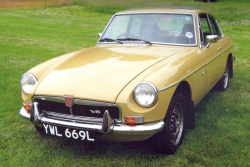 1973 MGB GT V8. Click image to enlarge |
Article and photo by Bill Vance
When the British MG arrived in North America it became the quintessential sports car, the very definition of the genre when it began landing here in the late 1940s. It came first as the neo-classic, square-cut, spider-wheeled MG TC, followed by the evolutionary TD and TF, then the modern envelope-bodied A and B models. But while MG was always the first sports car example cited, its performance was modest.
The TC and TD could barely break 130 km/h (80 mph), and the TF wasn’t much faster. It took until 1957 for the coupe version of the MGA to achieve the magical 161 km/h (100 mph). Competitors like Triumph, Austin-Healey and Morgan easily outran it.
The MGA was replaced by the MGB roadster for 1963, followed in 1965 by the MGB GT, a sporty hatchback coupe version with room for a couple of (very) small passengers in the rear. With styling inspired by Italy’s Pinanfarina, it provided the performance of the roadster with the comfort of a sedan.
After struggling for two years with the poor selling MGC, powered by an Austin 3.0-litre six, British Leyland (MG’s parent) thought a better bet for power and performance might be the GT with a Daimler V8. It didn’t get past the prototype stage.
This didn’t deter privateer Ken Costello, an engineer who operated Costello Motor Engineering in Kent, from doing his own experiments. He was particularly impressed by the quietness, power and light weight of Rover’s 3.5-litre V8.
The overhead valve aluminum V8 had been designed by General Motors and introduced in the 1961 Buick Special and Oldsmobile F-85 intermediates. But GM soon found that a cast iron V6 was cheaper to build and offered about the same performance so it sold the little V8 to the Rover Company, who used it in Rover cars and Land Rover/Range Rover utility vehicles. It would also power the Morgan Plus-8 and Triumph TR8.
In 1970, Costello bought a V8 engine from Rover and fitted it to an MGB GT to create his own MGB GT V8. The performance, as expected, was outstanding, and even though Costello did almost no advertising, his shop was soon turning out GT V8s at the rate of about one a week. A bonus was that the V8 engine was actually lighter than the MG’s 1.8-litre four.








